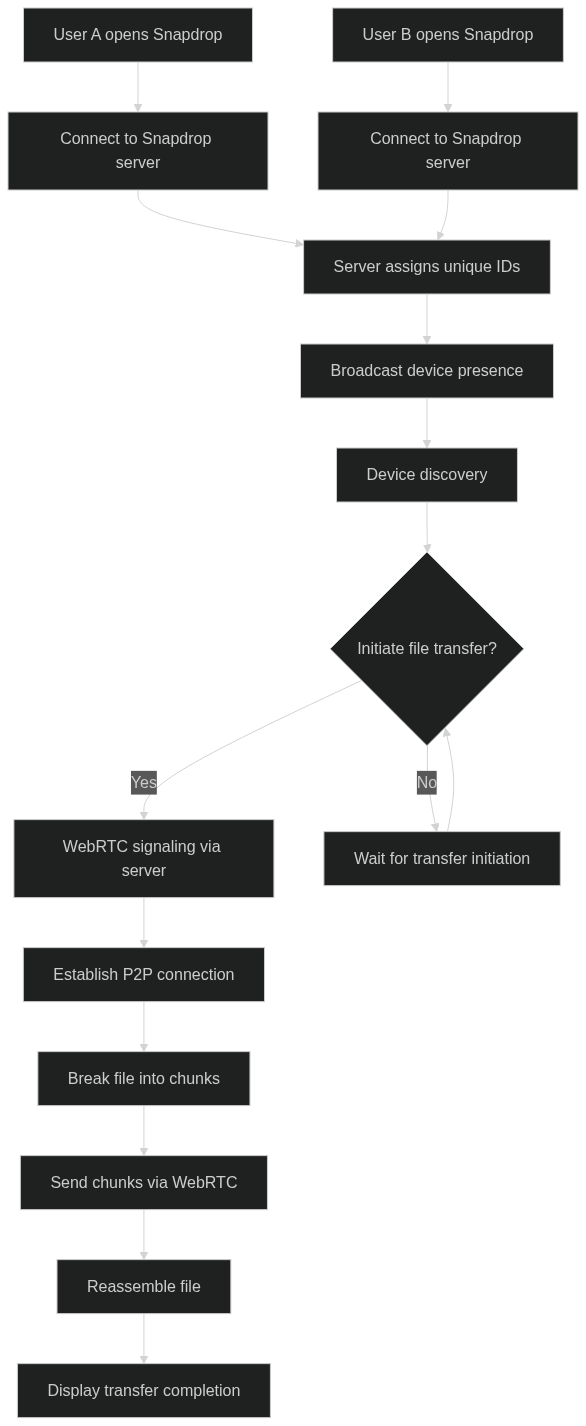Table of Contents
- Introduction: The File-Sharing Revolution
- What is Snapdrop?
- The Technology Behind Snapdrop
- How Snapdrop Works: A Step-by-Step Breakdown
- Snapdrop's Unique Features
- Security and Privacy Considerations
- Use Cases and Applications
- Comparing Snapdrop to Other File-Sharing Solutions
- The Future of Snapdrop and P2P File Sharing
- How to Get Started with Snapdrop
- Conclusion: Embracing the Future of File Sharing
Introduction: The Evolution of Peer-to-Peer File Sharing
In the realm of digital communication, the efficient and secure transfer of data has long been a critical challenge for both individuals and organizations. The advent of peer-to-peer (P2P) technologies has precipitated a paradigm shift in how we conceptualize and implement file sharing systems. Among these innovations, Snapdrop emerges as a particularly intriguing case study, offering a web-based solution that circumvents traditional file transfer limitations.
This blog post aims to provide a comprehensive analysis of Snapdrop's underlying architecture, exploring its utilization of cutting-edge web technologies such as WebRTC (Web Real-Time Communication) and Progressive Web App (PWA) frameworks. By examining Snapdrop's approach to device discovery, connection establishment, and data transfer, we seek to elucidate the mechanisms that enable its seamless, cross-platform functionality.
Furthermore, this investigation will contextualize Snapdrop within the broader landscape of file sharing methodologies, comparing its performance, security features, and user experience to conventional alternatives. Through this analysis, we aim to shed light on the potential implications of web-based P2P file sharing for future developments in digital communication and collaboration tools.
What is Snapdrop?
Snapdrop (https://snapdrop.net/) is an open-source, web-based file-sharing platform that allows users to transfer files between devices instantly, without the need for apps, plugins, or user accounts. It's like AirDrop, but for any device with a web browser. Snapdrop's beauty lies in its simplicity and accessibility – just open the website on two devices on the same network, and you're ready to start sharing files!
The Technology Behind Snapdrop
To truly appreciate the genius of Snapdrop, we need to understand the cutting-edge technologies that power this platform. Let's break it down:
WebRTC: The Core of Snapdrop
At the heart of Snapdrop's functionality is WebRTC (Web Real-Time Communication). This powerful technology enables direct peer-to-peer communication between web browsers, allowing for real-time data transfer without intermediary servers. Here's why WebRTC is crucial for Snapdrop:
- Direct Connection: WebRTC establishes a direct connection between devices, ensuring faster transfers and improved privacy.
- Low Latency: The peer-to-peer nature of WebRTC reduces latency, making file transfers lightning-fast.
- Cross-Platform Compatibility: WebRTC works across different devices and operating systems, making Snapdrop universally accessible.
Progressive Web App (PWA) Architecture
Snapdrop is built as a Progressive Web App (PWA), which combines the best of web and mobile apps. This architecture offers several advantages:
- Offline Functionality: Users can access Snapdrop even without an internet connection, thanks to service workers that cache the application.
- Installation-Free: No need to download and install an app – Snapdrop works directly in the browser.
- Responsive Design: The PWA adapts to different screen sizes, providing a consistent experience across devices.
Server-Side Implementation
While Snapdrop primarily relies on peer-to-peer connections, it does use a lightweight server for initial device discovery and connection establishment. The server is implemented using Node.js and handles the following tasks:
- Device Discovery: Helps devices on the same network find each other.
- WebSocket Signaling: Facilitates the initial handshake between peers before establishing a direct WebRTC connection.
- STUN/TURN Server: Assists in NAT traversal and fallback options when direct peer-to-peer connections aren't possible.
How Snapdrop Works: A Step-by-Step Breakdown
Now that we've covered the underlying technologies, let's walk through the process of how Snapdrop operates. The following diagram illustrates the workflow:

Let's break down each step of the process:
- Device Connection:
- User A and User B open Snapdrop in their web browsers.
- Both devices connect to the Snapdrop server via WebSocket.
- The server assigns a unique identifier to each device.
- Device Discovery:
- The server broadcasts the presence of each device to others on the same network.
- User A's device discovers User B's device, and vice versa.
- WebRTC Signaling:
- When User A initiates a file transfer to User B, their device sends a WebRTC offer through the server.
- The server relays this offer to User B's device.
- User B's device responds with a WebRTC answer, which is sent back through the server to User A.
- Peer Connection Establishment:
- Using the exchanged signaling information, the two devices establish a direct WebRTC peer connection.
- File Transfer:
- User A selects a file to send.
- The file is broken down into chunks and sent directly to User B's device over the WebRTC data channel.
- User B's device reassembles the chunks into the complete file.
- Transfer Completion:
- Once the file transfer is complete, both devices display a confirmation message.
- The peer connection can be kept alive for further transfers or closed if no longer needed.
This process happens seamlessly and quickly, giving users the impression of instant file sharing.
Snapdrop's Unique Features
Snapdrop stands out from other file-sharing solutions due to its innovative features:
- No User Accounts: Snapdrop doesn't require users to create accounts or log in, preserving privacy and simplifying the sharing process.
- Cross-Platform Compatibility: Whether you're using Windows, macOS, Linux, iOS, or Android, Snapdrop works flawlessly across all platforms with a modern web browser.
- Local Network Operation: By operating within local networks, Snapdrop provides faster transfer speeds and enhanced security.
- Multiple File Support: Users can send multiple files simultaneously, making bulk transfers a breeze.
- Text Sharing: In addition to files, Snapdrop allows users to share text snippets quickly.
- QR Code Sharing: For easy connection between mobile devices, Snapdrop generates QR codes that can be scanned to initiate transfers.
Security and Privacy Considerations
Security is a top priority for Snapdrop. Here's how the platform ensures your data remains safe:
- End-to-End Encryption: All file transfers are encrypted using WebRTC's built-in encryption protocols.
- No Cloud Storage: Files are transferred directly between devices, never touching cloud servers.
- Open-Source: Snapdrop's code is open-source, allowing for community review and verification of security practices.
- Temporary Connections: Peer connections are temporary and closed after transfers, reducing the attack surface.
- Local Network Limitation: By default, Snapdrop only works within local networks, minimizing exposure to external threats.
Use Cases and Applications
Snapdrop's versatility makes it suitable for various scenarios:
- Business Collaboration: Quickly share documents and files during meetings or across departments.
- Educational Settings: Facilitate easy file sharing between students and teachers in classrooms or study groups.
- Personal Use: Transfer photos, videos, and documents between your own devices without cloud services.
- Event Photography: Share photos instantly with attendees at events or parties.
- Tech Support: Easily send screenshots or log files when troubleshooting technical issues.
Comparing Snapdrop to Other File-Sharing Solutions
To truly appreciate Snapdrop's innovation, let's compare it to other popular file-sharing methods:
| Feature | Snapdrop | Cloud Storage | USB Drives | |
|---|---|---|---|---|
| Setup Required | None | Account needed | Account needed | Physical device |
| Speed | Fast (local network) | Varies | Depends on internet | Fast |
| File Size Limits | None (browser limits apply) | Often limited | Varies by plan | Limited by drive capacity |
| Privacy | High (P2P) | Moderate | Varies | High |
| Cross-Platform | Yes | Yes | Yes | Limited |
| Ease of Use | Very High | High | Moderate | Moderate |
As we can see, Snapdrop combines the best aspects of various file-sharing methods while eliminating many of their drawbacks.
The Future of Snapdrop and P2P File Sharing
The success of Snapdrop points to a bright future for peer-to-peer file sharing technologies. Here are some potential developments we might see:
- Enhanced WebRTC Capabilities: As WebRTC technology evolves, we can expect even faster and more reliable file transfers.
- Expanded Device Support: Integration with smart home devices and IoT gadgets could make Snapdrop a universal file-sharing solution.
- Improved NAT Traversal: Advancements in NAT traversal techniques could make it easier for Snapdrop to work across different networks.
- Blockchain Integration: Future versions might incorporate blockchain technology for enhanced security









No comments:
Post a Comment